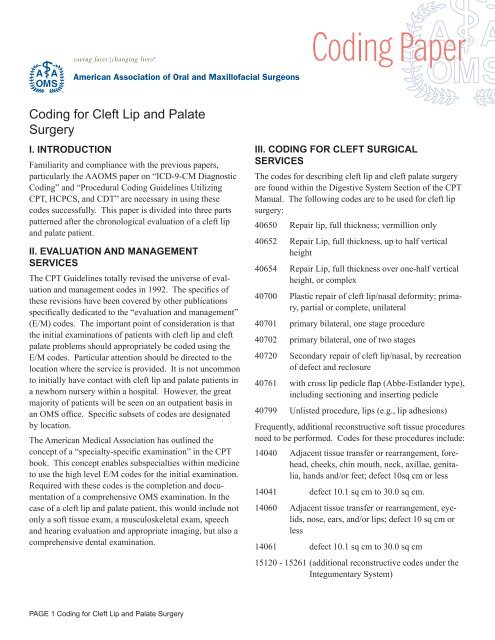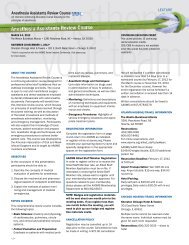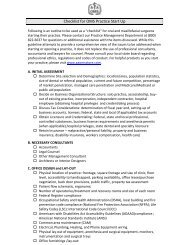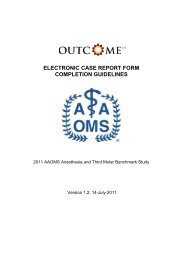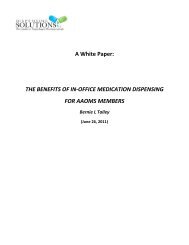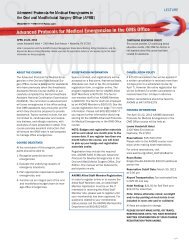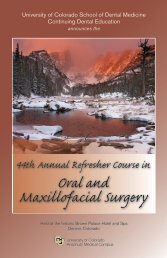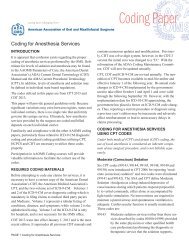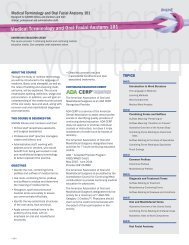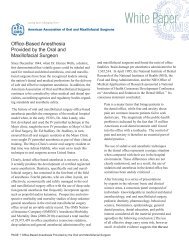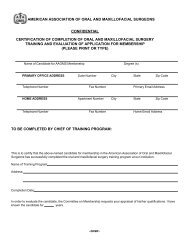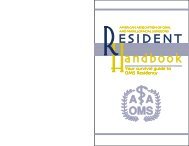Coding for Cleft Lip and Palate Surgery - American Association of ...
Coding for Cleft Lip and Palate Surgery - American Association of ...
Coding for Cleft Lip and Palate Surgery - American Association of ...
You also want an ePaper? Increase the reach of your titles
YUMPU automatically turns print PDFs into web optimized ePapers that Google loves.
15576 Formation <strong>of</strong> direct or tubed pedicle, with orwithout transfer; eyelids, nose, ears, lips, orintraoralCodes used to describe cleft palate surgery (Codes arelocated in the Digestive System heading under the Section<strong>of</strong> <strong>Palate</strong> <strong>and</strong> Uvula) to include the alveolus, anterior/posteriorhard palate <strong>and</strong> s<strong>of</strong>t palate, are as follows:42200 Palatoplasy <strong>for</strong> cleft palate, s<strong>of</strong>t <strong>and</strong>/or hardpalate only42205 Palatoplasty <strong>for</strong> cleft palate, with closure <strong>of</strong> alveolarridge; s<strong>of</strong>t tissue only42210 Palatoplasty <strong>for</strong> cleft palate with bone graft toalveolar ridge (includes obtaining graft). Thisincludes grafting from the alveolar crest to thepiri<strong>for</strong>m rim.• Note 1: To report a bone graft to an alveolarcleft as a secondary procedure <strong>for</strong>ridge augmentation, without a palatoplasty,use code 21210. For example: a child hada successful alveolar graft at 9 years old,patient is now ready <strong>for</strong> a dental implant.Additional bone stock is needed to supportthe dental implant.• Note 2: When a separate surgeon harveststhe bone or other tissues through a separateskin incision use code 20902. See below• Note 3: regarding bilateral clefts. Themodifier -50 would logically apply, however,the Medicare, Medically Unlikely Edit(MUE) policy prohibits using the bilateralmodifier with the 42210. There<strong>for</strong>e; there isno distinction between repair <strong>of</strong> a unilateral<strong>and</strong> bilateral alveolar cleft <strong>and</strong> there is nota separate bilateral cleft code. You mayconsider using the -22 (unusual difficulty)modifier <strong>for</strong> bilateral clefts.• Note 4: codes 42200, 42205, 42210, 30600<strong>and</strong> 42260 cannot be used together as aresult <strong>of</strong> the Correct <strong>Coding</strong> Initiative (CCIedits). However; it is appropriate to use themodifier -59, if the services are distinctlyseparate. For example, regarding a patientwith a naso-alveolar cleft <strong>and</strong> a oronasalfistula <strong>of</strong> the posterior hard palate (repair<strong>of</strong> the naso-alveolar fistula extending intothe anterior hard palate/premaxilla <strong>and</strong> thePAGE 2 <strong>Coding</strong> <strong>for</strong> <strong>Cleft</strong> <strong>Lip</strong> <strong>and</strong> <strong>Palate</strong> <strong>Surgery</strong><strong>Coding</strong> Papernaso-labial fistula is considered integral tothe alveolar cleft repair). If you choose torepair <strong>of</strong> a naso-alveolar cleft <strong>and</strong> oral–nasalfistula <strong>of</strong> the posterior hard palate at thesame time. Using 42210-59, 30600-59 (or42200-59 as appropriate) is acceptable, ifdenied an appeal is justified.41899 Extraction <strong>of</strong> teeth during cleft palate surgery.Specify difficulty with ICD-9/10 code. Forexample: removal <strong>of</strong> an impacted supernumerarytooth in the cleft (520.1) or removal <strong>of</strong> a decayederupted primary incisor in the cleft (521.0).42215 Palatoplasty <strong>for</strong> cleft palate; major revision42220 Palatoplasty <strong>for</strong> cleft palate, secondary lengtheningprocedure42225 Palatoplasty <strong>for</strong> cleft palate, attachment pharyngealflap42226 Lengthening <strong>of</strong> palate <strong>and</strong> pharyngeal flap42227 Lengthening <strong>of</strong> palate, with isl<strong>and</strong> flap42235 Repair <strong>of</strong> anterior palate, including vomer flap42260 Repair <strong>of</strong> nasolabial fistula20902 Bone harvest any area, major or large. Codeused <strong>for</strong> obtaining autogenous bone or othertissues through a separate skin incision by aseparate surgeon than per<strong>for</strong>ming the primaryprocedure. If the primary procedure “includesobtaining the graft” use the -52 modifier on theprimary procedure <strong>for</strong> reduced services or bothsurgeons may report the primary procedure codeappended by the -62 modifier. For example: surgeon#1 repairs a unilateral cleft: use 42210-52.Surgeon #2 harvest bone from the iliac crest <strong>and</strong>does not assist in the surgery: use 20902-6230580 Repair fistula; oromaxillary (combine with31030 if antrotomy is included)30600 Repair oral-nasal fistulaAdditional procedure codes include:30400-30630 Rhinoplasty, septoplasty, nasal regionrepair codes
Recommendations by the AAOMS Committee on HealthCare <strong>and</strong> Advocacy (CHCA) <strong>for</strong> procedures used <strong>for</strong>treating patients with cleft lip <strong>and</strong> palate de<strong>for</strong>mities <strong>for</strong>which there are no specific CPT codes:Prosthethetic devices used as adjuncts <strong>for</strong> cleft lip <strong>and</strong>palate treatment:42280 Maxillary impression <strong>for</strong> palatal prosthesis: Use42280 <strong>for</strong> taking an impression in the <strong>of</strong>fice, youmay choose to use the -22 modifier if the impressionis made under anesthesia.42281 Insertion palatal prosthesis: use 42281 if theprosthesis is fabricated by a laboratory (NOTby the provider) <strong>and</strong> delivered/inserted by theprovider where limited adjustments are required.21085 Impression <strong>and</strong> custom preparation <strong>of</strong> oral surgicalsplint:The AAOMS CHCA does NOT recommend theuse <strong>of</strong> this code <strong>for</strong> cleft palate prosthesis. Thiscode should be used <strong>for</strong> provider fabricatedsplints in conjunction with orthognathic surgery.21084 Speech aid prosthesis21076 Prepare facial/oral prosthesis: includes takingimpression(s), custom preparation <strong>and</strong> delivery/insertion <strong>for</strong> the prosthesis. It is assigned a 10day global surgical package, there<strong>for</strong>e, Subsequentadjustments beyond 10 days may be billedwith <strong>and</strong> E&M code. Pre-surgical Nasoalveolarmoulding (NAM) best fits within this codeTongue Flap <strong>for</strong> closure <strong>of</strong> a large palatal fistula:15576 Tongue flap: anterior <strong>of</strong> posterior based pedicledflap.21110 Application <strong>of</strong> intermaxillary fixation: MMF notin conjunction with facial fracture.15600 Sectioning (division <strong>and</strong> inset) <strong>of</strong> the flap at thetrunk: use this code when the tongue flap is “takendown” post-op. Includes plasty <strong>of</strong> the dorsaltongue <strong>and</strong> pedicle attached to the palate.The AAOMS Committee on Health Care <strong>and</strong> Advocacyrecommends that the oral <strong>and</strong> maxill<strong>of</strong>acial surgeon usethe CPT codes described <strong>for</strong> cleft lip <strong>and</strong> palate surgeryrather than the <strong>American</strong> Dental <strong>Association</strong>’s CurrentDental Terminology (CDT) codes.<strong>Coding</strong> PaperIII. MODIFIERS FOR CLEFT LIP AND PALATESURGERYThe following code modifiers may have some applicationin the reporting <strong>of</strong> services <strong>for</strong> cleft lip <strong>and</strong> palate surgery.-50 Bilateral procedure-51 Multiple procedures-52 Reduced services-58 A planned, staged or related procedure/serviceby the same physician during the 90 day GSPpostoperative period.-59 distinctly separate services-62 Two surgeons-66 Surgical team-80 Assistant surgeonIV. DIAGNOSIS CODING FOR CLEFT LIP ANDPALATE SURGERYCorrect usage <strong>of</strong> the CPT (procedural) <strong>and</strong> the ICD-9-CM(diagnosis) <strong>Coding</strong> Systems require that the appropriateICD-9-CM codes be linked to the surgical procedureslisted in the CPT universe. There is a great degree <strong>of</strong>specificity that has been built into the ICD-9-CM sectionunder congenital anomalies to cover the spectrum <strong>of</strong>disorders associated with the cleft lip <strong>and</strong> palate de<strong>for</strong>mity.The following fifth-digit <strong>of</strong> the ICD-9-CM codes are usedto describe the different congenital anomalies:749.0 <strong>Cleft</strong> <strong>Palate</strong>749.00 <strong>Cleft</strong> palate, unspecified749.01 Unilateral, complete749.02 Unilateral, Incomplete749.03 Bilateral, complete749.04 Bilateral, incomplete749.1 <strong>Cleft</strong> <strong>Lip</strong> (Cheiloschisis, harelip, congenitalfisure <strong>of</strong> lip, <strong>and</strong> Labium leporinum)749.10 <strong>Cleft</strong> lip, unspecified749.11 Unilateral, completePAGE 3 <strong>Coding</strong> <strong>for</strong> <strong>Cleft</strong> <strong>Lip</strong> <strong>and</strong> <strong>Palate</strong> <strong>Surgery</strong>
749.12 Unilateral, incomplete749.13 Bilateral, complete749.14 Bilateral, incomplete749.2 <strong>Cleft</strong> <strong>Palate</strong> with <strong>Cleft</strong> <strong>Lip</strong> (Cheilopalatoschisis)749.20 <strong>Cleft</strong> palate with cleft lip, unspecified749.21 Unilateral, complete749.22 Unilateral, incomplete749.23 Bilateral, complete749.24 Bilateral, incomplete749.25 Other combinations750.2 Other Specified Anomalies <strong>of</strong> Mouth <strong>and</strong>Pharynx750.25 Congenital fistula <strong>of</strong> lipCongenital (mucous) lip pits520.1 Tooth codes pertinent to cleft palate codes520.0 Congenital missing teeth520.6 Impacted teeth, eruption disturbance520.1 Supernumerary toot520.3 Mottled teeth520.1 Decayed teeth521.6 Ankylosed tooth“V51 Aftercare involving the use <strong>of</strong> plastic surgery”should be used when applicable <strong>for</strong> reportingplastic surgery following healed injury oroperation<strong>Coding</strong> PaperV. Global Surgical Package (GSP)The global surgical package concept is in effect <strong>for</strong> theCPT codes used to describe cleft lip <strong>and</strong> palate surgery.It is defined by CPT that use <strong>of</strong> the procedure code on aclaim <strong>for</strong>m will cover one related E/M encounter on thedate immediately prior to or on the date <strong>of</strong> the procedure(subsequent to the decision <strong>for</strong> surgery), the surgical care(the operation), <strong>and</strong> both post-operative care in the hospital<strong>and</strong> in the <strong>of</strong>fice. The global period <strong>of</strong> follow-up <strong>for</strong> cleftsurgical services is generally 90 days.Note: This paper should not be used as the sole reference in coding.Both diagnosis <strong>and</strong> treatment codes change frequently, <strong>and</strong> insurancecarriers may differ in their interpretations <strong>of</strong> the codes.<strong>Coding</strong> <strong>and</strong> billing decisions are personal choices to be made byindividual oral <strong>and</strong> maxill<strong>of</strong>acial surgeons exercising their own pr<strong>of</strong>essionaljudgment in each situation. The in<strong>for</strong>mation provided to you inthis paper is intended <strong>for</strong> educational purposes only. In no event shallAAOMS be liable <strong>for</strong> any decision made or action taken or not takenby you or anyone else in reliance on the in<strong>for</strong>mation contained in thisarticle. For practice, financial, accounting, legal or other pr<strong>of</strong>essionaladvice, you need to consult your own pr<strong>of</strong>essional advisers.This is one in a series <strong>of</strong> AAOMS papers designed to providein<strong>for</strong>mation on coding claims <strong>for</strong> oral <strong>and</strong> maxill<strong>of</strong>acial surgery(OMS). This paper discusses coding <strong>for</strong> <strong>Cleft</strong> <strong>Lip</strong> <strong>and</strong> <strong>Palate</strong><strong>Surgery</strong>. This paper is to aid the oral <strong>and</strong> maxill<strong>of</strong>acial surgeonwith proper diagnosis (ICD-9-CM) <strong>and</strong> treatment (CPT/CDT)coding <strong>for</strong> <strong>Cleft</strong> <strong>Lip</strong> <strong>and</strong> <strong>Palate</strong> <strong>Surgery</strong>. When indicated, you willbe referred to the appropriate area <strong>of</strong> the coding books where theprinciples <strong>of</strong> coding illustrated in this paper may be applied.Proper coding provides a uni<strong>for</strong>m language to describe medical,surgical, <strong>and</strong> dental services. Diagnostic <strong>and</strong> procedure codesare continually updated or revised. The AAOMS Committee onHealth Care <strong>and</strong> Advocacy has developed these coding guidelinesin order to assist the membership to use the coding systemseffectively <strong>and</strong> efficiently.© 2013 <strong>American</strong> <strong>Association</strong> <strong>of</strong> Oral <strong>and</strong> Maxill<strong>of</strong>acial Surgeons.No portion <strong>of</strong> this publication may be used or reproduced withoutthe express written consent <strong>of</strong> the <strong>American</strong> <strong>Association</strong> <strong>of</strong> Oral<strong>and</strong> Maxill<strong>of</strong>acial Surgeons.Revised March 2013PAGE 4 <strong>Coding</strong> <strong>for</strong> <strong>Cleft</strong> <strong>Lip</strong> <strong>and</strong> <strong>Palate</strong> <strong>Surgery</strong>


